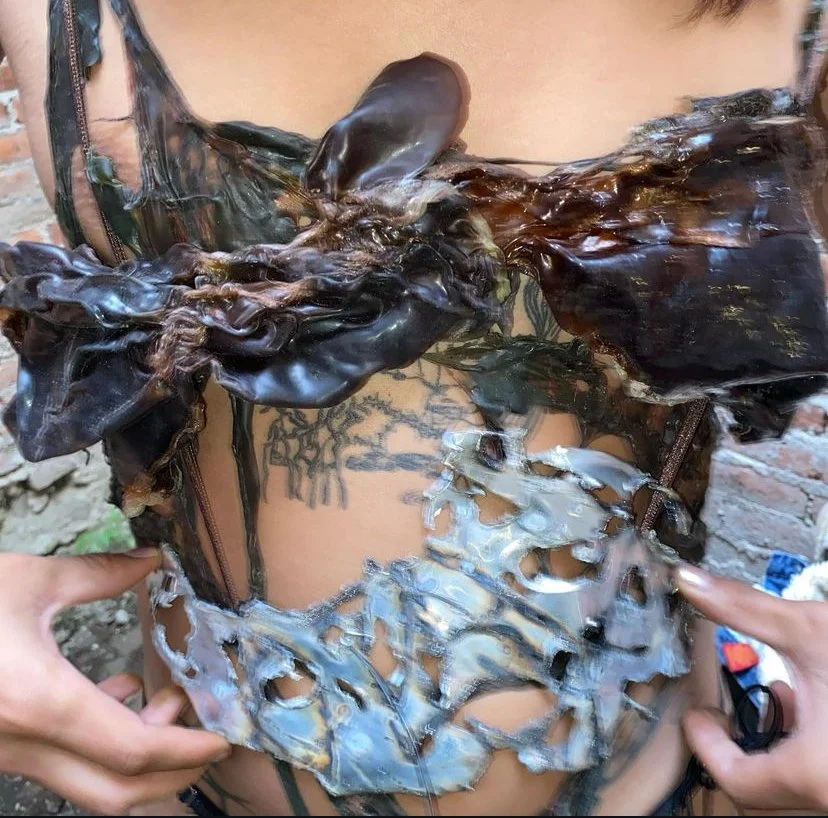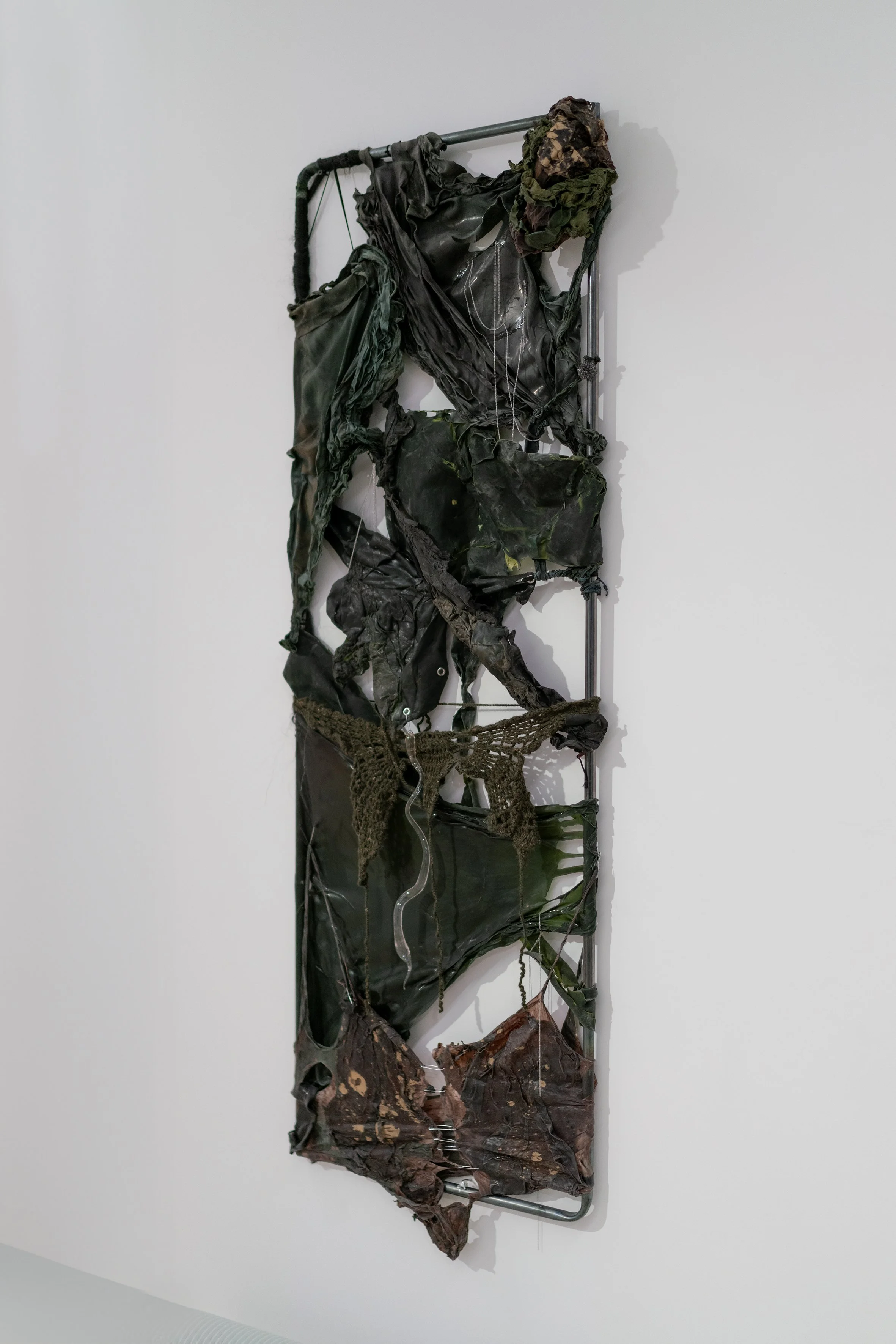ANOUSHA ON SWAMPCORE, SELF-CENSORSHIP, AND INHABITABLE BODIES
Anousha operates from a place that refuses containment—of form, of identity, of history. Her early practice was driven by a visceral need to create organic material — an almost desperate desire to make bodies. Over time, that urgency drifted toward the marsh: liminal, elusive ecosystems where everything parasitizes everything else. Her thesis, Swampcore, was not just an ecological study; it was a mapping of identity itself and what it means to belong to nothing clean, nothing fully legible. In Anousha’s work, the swamp becomes both method and metaphor: a naturally chaotic space where fluidity, decay, regeneration, and hybridity coexist. It reflects her own negotiation between Iranian cultural memory, diasporic displacement, and the collective inheritance of bodies marked by regimes of control. Her current materials — latex, glass, hybrid organic substances — resist purity. They contradict themselves: fragile yet cutting, alluring yet repelling, transparent yet concealing. They mirror the contradictions of survival under patriarchy and dictatorship, where dissociation becomes a form of resilience. A pivotal point in Anousha’s work came during her glassmaking residency in Iran, when conversations with women across generations exposed the subterranean forces that shape subjectivity under oppression. Their stories — layered with silence, rupture, and myth — gave rise to You Can't See What's Under Mom's Skin, a project that maps the invisible architectures of trauma, matriarchy, and survival. Anousha’s practice reminds us that memory is not static. It is embodied in a sacred natural web of layers, leaking and mutating as experience grows. In a bi-polar world that demands clarity, her work insists on murkiness, not as evasion, but as an ode to authenticity.
AASI: In Swampcore, you propose the swamp as a space of resistance, memory, and porosity. What drew you to this particular metaphor? What does the swamp let you express that the desert or city cannot?
ANOUSHA: During the COVID lockdowns, I started noticing a shift—both in myself and in culture at large. There was a growing aesthetic and conceptual fascination with swamps, especially in post-internet spaces. That’s when I realized my own attraction to wetlands wasn’t just personal—it was collective.
The confinement of that time created a longing to reconnect with tactile, intimate ecologies: mud, mold, the so-called unclean. The swamp became a symbol for what hygiene culture rejects—something unruly, nonbinary, nonsterile. I saw it as an ally. As someone who grew up in Iran, in a kind of mental confinement, while feeling like a fluid body with fluid desires, the swamp offered me a metaphor that held all those contradictions.
What’s crucial about swamps is their in-betweenness. Water and land bleed into each other. You can’t draw a clean boundary. That porosity—that refusal of legibility—is what I relate to. It’s not just metaphorical for me; it’s methodological. The swamp teaches me how to make work: through layering, contamination, transformation.
AASI: Your practice often centers invisible life—bacteria, mycelium, ghosts, even voice. What draws you to the unseen? What political weight does it carry?
ANOUSHA: There’s something powerful about what can’t be captured easily. Bacteria, spirits, even glass, they exist on the edge of visibility. They seduce, but they also withhold. Glass, for instance, is both a barrier and a portal. It reflects and reveals. That duality speaks to me.
In my work, I’m not interested in giving viewers a clean, didactic message. That might be something I do as an activist in conversation. But in art, I want to pull people into my inner texture—my dissonance, my contradictions. The invisible becomes a way of building that intimacy, that ambiguity. It refuses certainty. It asks people to feel rather than decode.
AASI: You’ve described embodiment as a form of dissociation—and your work as an attempt to construct a body that feels inhabitable. Can you speak more to that tension?
ANOUSHA: Despite everything I’ve made, I still don’t feel like I have a body that fully belongs to me. But maybe that’s not the point. I think every body is made—culturally, politically, imaginatively. Mine is no exception.
My work isn’t about reclaiming some “true” form. It’s about building a form I can live in, even if only temporarily. A body that can hold contradiction, softness, rupture. That’s what I mean by “inhabitable.” Not comfortable. Not natural. Just survivable.
AASI: In Iran, the body becomes a site of control. In exile, it becomes a site of projection. Where, if anywhere, does your body feel like it’s truly yours?
ANOUSHA: If anywhere, it’s in that unstable, swampy space I keep returning to. In Iran, I was surveilled. In Europe, I’m romanticized. Neither feels like mine. One punishes. The other consumes.
The in-between doesn’t offer safety, but it offers honesty. At least there, I can contradict myself and still be whole. I don’t have to choose between silence and spectacle. I can shapeshift.
AASI: You've spoken about matrilineal memory—about stories passed down through gesture and silence rather than language. How does that live in your work?
ANOUSHA: That’s the very core of it. A couple of years ago, I started spending summers in Iran again. It was right after the Woman, Life, Freedom uprising. And I started noticing this strange coherence—how my grandmother’s stories echoed those of my best friend’s mother, or my aunt, or my own body memories. They were different voices, but the structure underneath was the same.
That transmission doesn’t happen through words. It happens through flesh. Through breath. Through what is left unsaid. My work tries to hold that space.
AASI: You once said your archive would resemble a womb—not as a symbol of motherhood, but as something dense and ambiguous. Can you expand on that?
ANOUSHA: Yes. A womb—not in a romantic or maternal sense—but as a chamber. A dense, almost claustrophobic place. It holds things before they have names. Before they’re allowed to be.
My archive feels like that. Soft, internal, full of tension. It’s intimate—but not safe. Not everything that forms inside survives. But that’s also what makes it potent.







